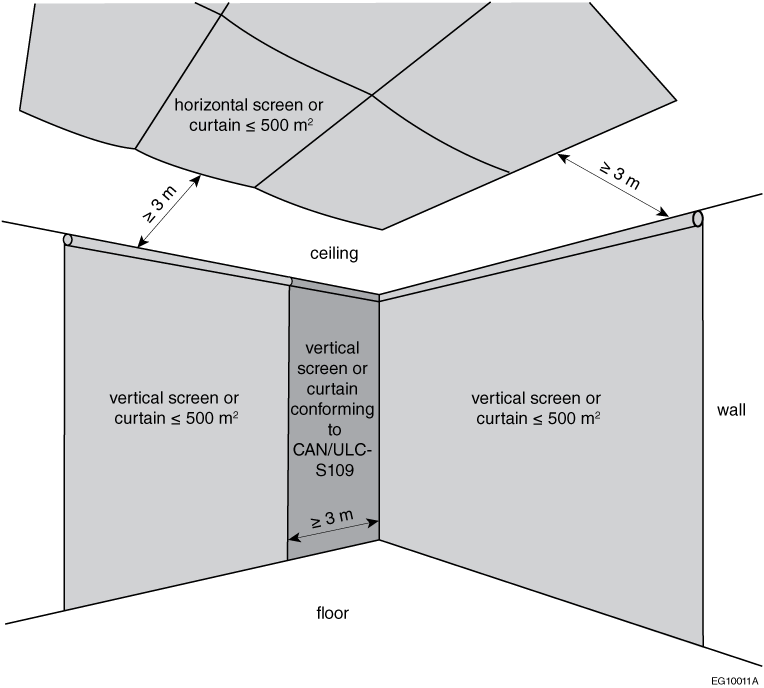Problem
Article 2.3.2.1. of Division B of the National Fire Code of Canada (NFC) requires that fabrics and films be flame resistant when used in open floor areas exceeding 500 m2 in certain occupancies. A similar requirement does not exist for screens and curtains used in agricultural occupancies.
Many agricultural occupancies use screens and curtains within the building envelope as part of the building use. Most notably, greenhouse operations often use blackout, energy conservation or light diffusion screens and curtains below ceilings and adjacent to walls to control growing conditions and reduce light pollution. These screens and curtains can be of significant size and, if exposed to flame, can contribute to the rapid spread of fire, which may delay evacuation and potentially cause harm to the occupants of the building.
Flame-resistant screens and curtains are currently available in the Canadian marketplace. The cost and continuity of farming operations are key issues within the agricultural industry. As such, reasonable provisions need to be added to the Code to balance these issues with the life-safety aspects of large farm buildings.
Justification
Sentence 2.3.2.1.(1) requires that drapes and curtains used in Group A, B1, D, E and F occupancies conform to CAN/ULC-S109, "Standard Method for Flame Tests of Flame-Resistant Fabrics and Films," in open floor areas exceeding 500 m2. However, this provision does not limit the size (i.e., areas) of the drapes or curtains.
The new provisions for large farm buildings introduced in the latest edition of the NFC allow most agricultural occupancies to have an unlimited building area; however, there are few requirements for fire compartmentalization within those buildings. Large, contiguous screen and curtain areas can promote the spread of fire and can delay persons from exiting the farm building safely.
To limit the probability of such a scenario, this proposed change would define the contiguous area of screens and curtains (for both horizontal and vertical applications) when used in agricultural occupancies that exceed the 500 m2 limit set in Clause 2.3.2.1.(1)(c).
Given the potential for screen and curtain use throughout the unlimited floor areas in large farm buildings, this proposed change would provide the following suitable methods for dividing large screens and curtains into non-contiguous areas:
- providing physical space between sections of screens and curtains,
- including fire separations where feasible, and
- making use of fire breaks using fabrics tested in accordance with CAN/ULC-S109.
PROPOSED CHANGE
[2.3.2.] 2.3.2. Flame Resistance
[2.3.2.1.] 2.3.2.1.Drapes, Curtains and Decorative Materials
[2.3.2.2.] 2.3.2.2.Flame-Retardant Treatments
[2.3.2.3.] 2.3.2.3.Textiles in Group B Occupancies
[2.3.2.4.] ---Textiles in Group G Occupancies
Note A-2.3.2.4.(1)
Note A-2.3.2.4.(2)
Examples of screens or curtains separated by a distance of at least 3 m or by a screen or curtain that is at least 3 m wide and that conforms to CAN/ULC-S109

Impact analysis
Most manufacturers of screens and curtains have flame-resistant options available; however, the standard to which they are tested varies. Some manufacturers may need to have their products tested in Canada before those products can enter the Canadian marketplace.
It is anticipated that the cost of flame-resistant screens and curtains conforming to CAN/ULC-S109 will be 15% to 65% higher than the cost of non-tested screens and curtains (based on information collected from one of the major suppliers in Canada). For example, applying the proposed requirements and using flame-resistant screens in a 20-acre greenhouse of typical area dimensions (400 m × 200 m) would increase the cost by 3% to 35% compared to using screens that are not tested to be flame-resistant. The range of the increase in cost depends on the purpose of the product (i.e., for blackout, energy conservation or light diffusion), whether both the ceiling and walls of the entire facility have screens installed, and which method is used to divide up the area of non-tested screens into non-contiguous areas less than 500 m2 (by separating them using materials listed in CAN/ULC-S109).
This proposed change will limit the risk to the life safety of occupants where large areas of screens or curtains are operationally required in agricultural occupancies. This proposed change will provide a number of practical options to limit the amount of flame-resistant materials needed in large open floor areas, thereby reducing the cost of compliance.
Enforcement implications
This proposed change can be enforced by the existing framework without additional resources. Authorities having jurisdiction are familiar with flame-test requirements for materials. The proposed methods for dividing curtains and screens are straightforward and easy to implement in practice.
Who is affected
People concerned with the design, construction and operation of farm buildings, namely, engineers, architects, building owners and regulators.
OBJECTIVE-BASED ANALYSIS OF NEW OR CHANGED PROVISIONS
- Date modified:
